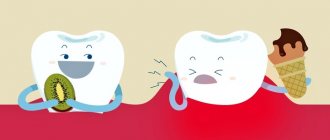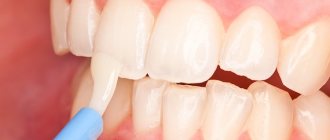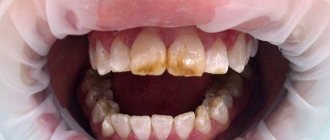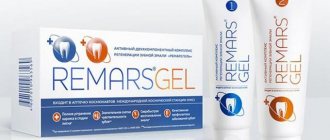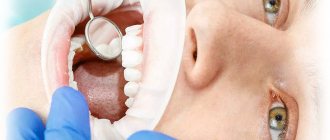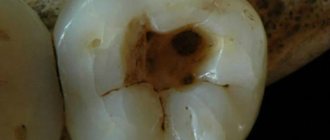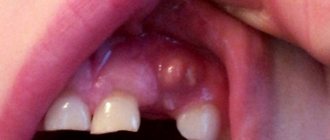Operating principle
Plaque that forms daily contains a huge amount of bacteria. By releasing acids of various compositions, bacteria destroy the enamel, as if dissolving the calcium molecules in it, and thereby deprive it of its protective properties. The compounds included in the RemarsGel complex have the ability to gradually penetrate the tooth enamel and replace lost calcium. “RemarsGel” actually “repairs” the area of tooth enamel that has lost its strength, strengthens it and helps restore the natural protection of the tooth.
During the process of brushing teeth with “RemarsGel”, calcium nitrate from tube No. 1 is mixed with ammonium hydrogen phosphate from tube No. 2. As a result of a safe chemical reaction, a brushite crystal is formed on the surface of the teeth, similar in composition to the main component of tooth enamel (hydroxyapatite crystal). Due to its small size, the brushite crystal penetrates deeply into tooth tissue, restores enamel damaged by caries, closes microcracks and quickly relieves tooth sensitivity (even after professional whitening). After a course of using RemarsGel, the enamel becomes smooth and shiny, and a feeling of smoothness of the surface of the teeth appears, as if after polishing.
Causes of tooth demineralization
Tooth enamel is destroyed for a number of reasons. Most often, a violation of the mineral composition is provoked by the following factors:
- Excessive consumption of sugar and sweets;
- Alcohol abuse, addiction to coffee and tea;
- Failure to adhere to proper nutrition;
- Drinking unfiltered or low-quality water;
- Lack of vitamins in the body;
- Constant stress.
The listed factors change the pH of saliva, which provokes demineralization. It is no secret that saliva is the main source of minerals for tooth enamel. Therefore, any imbalance in this environment leads to negative consequences. A lack of calcium, fluoride and other nutrients appears as white spots on the enamel. This is the first sign of demineralization.
Basic recommendations
Be sure to use RemarsGel 1-2 times a day. Both treatment and prevention must be strictly daily! "RemarsGel" can be used both at home and for treatment in a dental clinic.
The course of treatment of tooth enamel consists of 20-28 procedures. In case of visible damage to the teeth, “RemarsGel” should be used every day until the enamel is restored, and then – to consolidate the action of the complex 1-2 times a week.
For preventive effects, 10-14 procedures are sufficient. The prophylactic course of “RemarsGel” is recommended to be carried out 3 times a year.
Prevention of demineralization
To prevent demineralization at home, you should first take care of proper nutrition. The diet should include foods rich in fluoride, calcium and other substances that are beneficial for tooth enamel. These include:
- Legumes;
- Green vegetables;
- Milk and dairy products;
- Nuts.
In addition, it is recommended to reduce consumption or completely eliminate tea, coffee, carbonated drinks, and sugar from the diet.
A course of home remediation involves the use of special products aimed at restoring the mineral composition of tooth enamel. Retherapy gels will help provide this effect. For example, the following are well suited for these purposes:
- GC Tooth Mousse;
- Dental Resources (USA);
- ROCS Medicals Minerals.
To achieve maximum effect, it is better to fill the mouthguards with the listed gels. This way the composition does not come into contact with saliva and adheres to the enamel as tightly as possible. It is better to make custom-made mouthguards so that they accurately replicate the anatomical structure of the teeth.
Don't forget about proper oral care. In this case, irrigators will be indispensable. These are effective tools that remove food particles using a targeted jet of water. As a result, the mechanical impact on tooth enamel is reduced, so even people with hypersensitive teeth can use irrigators.
At the same time, we should not forget that preventive care products for demineralization of teeth should be selected by the attending physician. You should also contact your dentist if you experience any discomfort that occurs during tooth enamel retherapy.
Author of the article
Clinical study
RemarsGel is a product that has the unique ability to restore damaged or weakened tooth enamel that is ready for damage; it was originally called Remogel. Research on this drug took place at the Department of Pediatric Therapeutic Dentistry of the Moscow State Medical and Dental University. The purpose of the test was to determine the compliance of the Remogel gel with the possibility and feasibility of its use in dental institutions of the Russian Federation.
During the test, the simplicity and accessibility of the method of using the gel was revealed, and a pronounced remineralizing effect of the gel on foci of demineralization in caries was established. The study showed that Remogel successfully passed medical tests and can be recommended for widespread use in medical practice.
Dissertation of Doctor of Medical Sciences Volkov Evgeniy Alekseevich:
“Pathological changes in the hard tissues of teeth often begin with focal demineralization, leading to dental caries and its complications, as well as non-carious lesions, accompanied by dentin exposure and hyperesthesia. Therefore, mineralization of enamel and dentin, elimination of focal demineralization and hyperesthesia of teeth are a measure for the prevention of more severe pathological processes... A new generation of domestic dental materials and new methods of mineralizing therapy for the pathology of hard dental tissues with the material “BV” (for clinical use - approx. “Gekom”) and a set of gels “Remogel” (now “RemarsGel” - note by “Gekom”) were introduced into practical healthcare at the industry level (included in the State Register).”
Features of the procedure
Fluoridation (remineralization) is one of the most common methods of strengthening teeth and an excellent alternative to the once popular silvering procedure. It helps prevent caries in children of any age. Fluoridation is relevant for both permanent and baby teeth. It increases the resistance of enamel to cariogenic factors and prevents the development of serious dental pathologies. Doctors recommend this procedure for children starting at the age of 5. It is prescribed during the period of growth of baby teeth, during a change in bite and with enamel hypersensitivity.
The best products for remineralizing teeth –
All remineralization products can be divided into several groups:
- gels and varnishes with a high concentration of fluoride,
- sources of calcium and phosphates,
- combined products, where sources of calcium and phosphates are combined with fluorides.
Preparations with high concentrations of fluoride can only be used by a dentist. The effectiveness of fluorides for the remineralization of teeth should not be underestimated, and their effectiveness lies not only in increasing the resistance of enamel to acids (due to fluoridation of enamel apatite crystals). Fluorides have a multifaceted effect, for example, they enhance the phase transformations of mineral substances, accelerating the remineralization of enamel with calcium and phosphate ions contained in saliva or as part of a dental preparation.
In addition, when teeth are treated with high concentrations of fluorides, a so-called “sacrificial layer” is formed on the tooth enamel, consisting of globules of calcium fluoride (24stoma.ru). Subsequently, under the influence of acid attacks, this layer slowly dissolves (with the release of active calcium and fluoride ions), which activates the process of enamel remineralization. Some authors do not classify “fluoridation of teeth” as true “remineralization,” but as we see, this is completely in vain. Using fluoride for remineralization is the best choice if you need to protect your teeth from tooth decay.
But on the other hand, if we are talking about the treatment of the initial form of caries (in the white spot stage), as well as the need to strengthen the initially low-mineralized enamel (baby or recently erupted permanent children’s teeth), then fluorides will not be the optimal choice. In this case, the needs of the enamel are primarily calcium and phosphates, and not fluorides. And in this case, for remineralization we will use sources of calcium and phosphates (for example, Tus mousse gel) for a course of 25-30 days. You can conduct such a course yourself at home, and it is not at all difficult. Details below.
Fluoride varnish “MI VARNISH” (Mi Varnish) –
The drug "MI Varnish" is produced by the company GC, and it is an excellent professional tool for remineralizing teeth, intended for use in a dental office. The drug contains 5% sodium fluoride and Recaldent® complex (this name stands for CPP-ACP, namely “amorphous calcium phosphate associated with casein phosphopeptides”). CPP-ACP is one of the most effective calcium and phosphate compounds designed to remineralize teeth.
Varnish “MI Varnish” –
Research shows that adding CPP-ACP to 5% sodium fluoride provides 4 times more fluorapatite incorporation into tooth enamel (compared to using varnish with only 5% sodium fluoride). The drug is recommended for remineralization of dental tissues for the prevention of caries and dental hypersensitivity. The drug can be applied only once (once every 3-6 months) - as a periodic prevention of dental caries. Or we can use a short course of 2-3 procedures (with an interval of several days) - when we need intensive remineralization, for example, with increased sensitivity of teeth or a decompensated form of the carious process.
Clinpro White Varnish –
Clinpro White Varnish is produced by the famous American Varnish, and it contains a combination of protected tricalcium phosphate and 5% sodium fluoride. Tricalcium phosphate is a source of active calcium ions and phosphates (as is CPP-ACP in the preparation above). Applying varnish leads to the formation of a thin layer on the teeth, from which calcium and fluoride ions, phosphates will penetrate into the tooth enamel within 24 hours, intensively remineralizing it.
Clinpro White Varnish Remineralizer –
The cost of treatment will be from 2600 rubles for both jaws. Depending on the condition of the teeth and the quality of oral hygiene, either a single procedure every 3-6 months may be recommended, or, if intensive remineralization is necessary, a course of 2-3 procedures with an interval of several days. This is a very good drug, but it must be said that if we compare different compounds (sources of calcium and phosphates) with each other, then in our opinion CPP-ACP will be slightly more preferable than tricalcium phosphate. That's why we put Clinpro White Varnish only in 2nd place.
Fluoride varnish “Colgate Duraphat” –
Colgate Duraphat Fluoride Varnish contains 5% sodium fluoride, which corresponds to 22,600 ppm of active fluoride ions. This is an excellent remedy specifically for the prevention of dental caries, if you carry out repeated procedures once every 3-6 months (the frequency depends only on the quality of your oral hygiene, and whether you consume carbohydrates between meals). The only limitation is that it will not be particularly effective in patients with dry mouth, because... To form a layer of calcium fluoride on the surface of the enamel, calcium ions contained in saliva are necessary. But for xerostomia, MI Varnish and Clinpro White Varnish, which already contain sources of calcium and phosphates, are quite suitable.
Colgate Duraphat Fluoride Varnish –
The cost of treating all teeth for a child is about 1,000 rubles, and for adults – about 2,000 rubles. Modern research shows that a single remineralization of teeth (once every 3-6 months) with varnishes and gels with 1% sodium fluoride can reduce the risk of developing caries by approximately 30%, and when using 5% sodium fluoride, this figure increases to 63%. . The varnish has excellent properties - it can be applied even to wet teeth, which sets it apart from most similar products that cannot be applied to wet teeth (this is especially important at a children's appointment).
In case of irregular oral hygiene, it is advisable to carry out the procedure every 3 months, and in case of regular hygiene – once every 6 months. This frequency of use will significantly reduce the risk of developing caries. If an intensive course of remineralization is necessary, 3-5 procedures are carried out within 1 week (usually this is the scheme that can be found in some textbooks on dentistry - when carrying out remineralization of white spots on the enamel, i.e. initial caries in the white spot stage).
Comparison of the effectiveness of fluoride varnishes and gels -
Preparations for remineralizing teeth containing high dosages of fluoride can be either in the form of varnishes or gels. Varnishes are much more effective because... By applying varnish, long-term contact of the enamel surface with the components of the drug is achieved (up to 24 hours). As for fluoride gels, they are introduced into the oral cavity in special spoons (drop trays), and the contact of the gel with tooth enamel will last only a few minutes. Therefore, we recommend that you carry out remineralizing therapy with preparations with a high fluoride content - only in the form of varnish.
Of the fluoride gels, the most effective are those that have an acidic pH of 3.0 to 4.0 (this is achieved by acidification with phosphoric acid). An acidic pH will allow the resulting calcium fluoride globules to adhere much more firmly to the enamel surface. Research shows that in this case, calcium fluoride is detectable (on the surfaces of teeth that are not subject to mechanical stress) – even several weeks after the application of the fluoride gel. Accordingly, a fluoride gel with an acidic pH will provide longer-lasting remineralization than a fluoride gel with a neutral pH.
An example of such an acidified gel is “Topex (Topical) APF gel”. Well, another advantage of fluoride gels is the lower cost of the procedure (compared to fluoride varnishes). In most clinics, the cost of fluoridation with gel using aligners averages from 800 to 1000 rubles for both jaws. This is ensured by both the lower price of consumables and significant time savings - the procedure for fluoridating teeth with gel takes only a few minutes. But we repeat once again that this option of fluoridation will not be effective in patients with reduced salivation.
Important: after fluoridation of teeth, the patient is prescribed toothpaste that has an increased remineralizing effect. For example, your dentist may recommend Clinpro Tooth Creme toothpaste, which contains a combination of tricalcium phosphate + 900 ppm sodium fluoride. Either “Biorepair PLUS Total Protection” or “APADENT Total Care”, which contain nano-hydroxyapatite (nanoparticles of an artificially synthesized analogue of natural tooth enamel). Or Colgate Duraphat 5000 ppm toothpaste, which contains a high dosage of sodium fluoride. Read more in the article at the link below.
→ Medicinal toothpastes
Disadvantages of remineralization with fluorides in the presence of foci of demineralization (white spots) –
All of the fluoride varnishes listed above with 5% sodium fluoride are excellent for strengthening enamel and protecting teeth from caries, but they will not be the optimal choice if there are foci of enamel demineralization (white spot caries). It should be noted that the main loss of calcium and phosphates occurs in areas of demineralization - not at all on the surface of the white spot, but in the subsurface layers of the enamel. Using a product with a high concentration of fluoride will lead to the formation of a white spot on the surface - a dense mineral “crust” with a high content of fluorapatite and fluorohydroxyapatite.
High fluoride content on the surface of the white spot –
Such a crust will impede the penetration of calcium and phosphate ions into the depths of the demineralization site. Therefore, although the initial use of high concentrations of fluorides may lead to a reduction in the size of demineralization foci, they will not allow you to get rid of them completely. Below you can see electron microscopy images of enamel, which clearly show the differences in the remineralization process, in cases where it is carried out only with sources of calcium and phosphates, and in the second case - with a preparation with a high fluoride content.
The photographs show that in the first case, a uniform decrease in the depth of the demineralization focus was achieved. In the second image, a reduction in the focus of demineralization has been achieved, but we see stripes (with a lighter color closer to the surface of the enamel), which indicates the formation of a highly mineralized layer of fluorapatite on the surface of the focus of demineralization. Therefore, if there are foci of demineralization, at the 1st stage it is necessary to use remineralizing preparations with sources of calcium and phosphates (preferably based on CPP-ACP), and only at the 2nd stage - to complete the remineralization course, coat the teeth with varnish with 5% sodium fluoride.
Types and purpose
Gum inflammation is a widespread problem. There are many reasons for it, but the results are always the same: they turn red and bleed, and there is an unpleasant odor from the mouth. Periodontists practice complex treatment: antibacterial medications for oral administration, physical therapy and local therapy.
For local therapeutic effects, antiseptics and analgesics are used in powders and rinsing solutions, but ointments and gels that act in a targeted, effective and long-lasting manner are more convenient. They are quickly absorbed, therefore they actively influence the affected tissues, shorten the healing time and alleviate the patient’s condition. Their peculiarity is the almost complete absence of contraindications, except for individual intolerance and a minimum of adverse reactions compared to other dosage forms.
All such preparations, spread and rubbed into the oral cavity, are usually classified into groups that differ in the basis that binds the active components:
- gels are water-soluble, they are light and have good absorption, so the active components immediately reach the diseased organ in full, in addition, the film formed on the surface acts as an additional protection for the mucous membrane:
- ointments are oily, have a dense and heavy consistency, which is poorly absorbed and washed off with saliva.
Only a doctor will be able to select the right type of medicine, based on the clinical picture of the disease and taking into account the individual characteristics of the patient.

